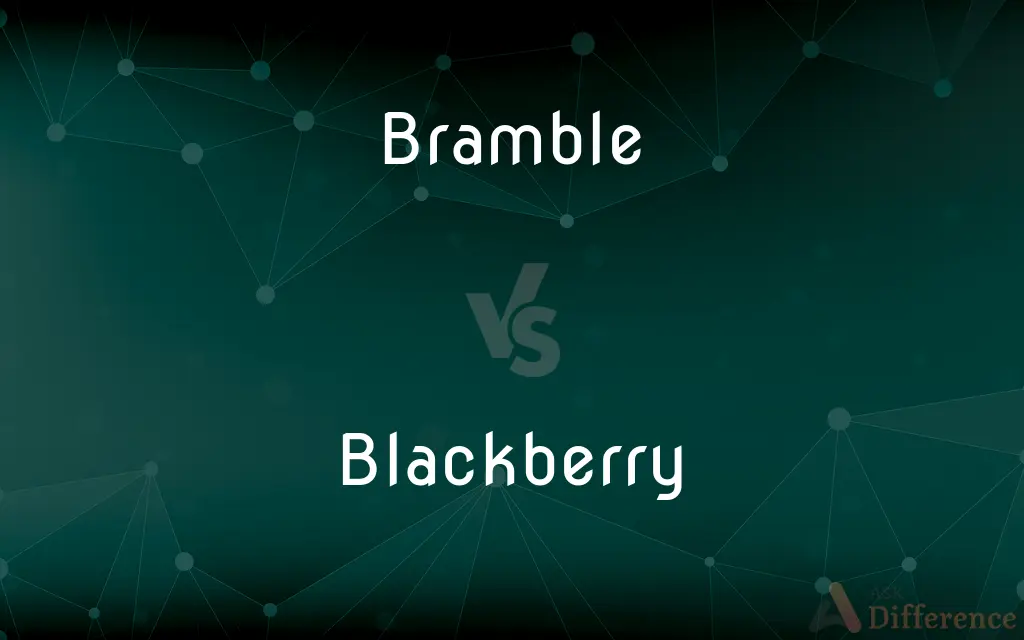Bramble vs. Blackberry — What's the Difference?
Edited by Tayyaba Rehman — By Maham Liaqat — Updated on March 22, 2024
Bramble refers to any rough, tangled, thorny shrub, often including blackberries, while blackberry specifically denotes the fruit-bearing plant known for its edible, dark berries.

Difference Between Bramble and Blackberry
Table of Contents
ADVERTISEMENT
Key Differences
Bramble is a term used broadly to describe any dense, thorny shrub, including various species within the genus Rubus, such as blackberries and raspberries. These plants are characterized by their tough, woody stems, thorns, and tendency to form dense thickets. In contrast, blackberry specifically refers to both the plant and the fruit of certain species within the Rubus genus, noted for their edible fruits that turn from red to black upon ripening.
While brambles are often considered invasive due to their rapid growth and ability to overrun areas, blackberries are cultivated both for personal consumption and commercially for their fruit. The distinction lies in the specific use and perception of the plants; brambles may be seen as nuisances in gardens and wild areas, whereas blackberries are valued for their delicious berries.
Brambles, including blackberry plants, have a life cycle that includes both a biennial cane growth and perennial root system. In the first year, the plants produce vegetative growth, which then bears fruit in the second year before dying off. However, when referring to blackberries, the focus is usually on the fruit-bearing second year of growth and the harvesting of the berries.
Care and maintenance for blackberries as a subset of brambles involve pruning the canes that have already fruited, to encourage new growth and fruit production in the following season. Conversely, managing bramble thickets often requires more aggressive measures to prevent them from becoming too dense and encroaching on other plants or areas.
The fruit of the blackberry plant is known for its nutritional benefits, including high levels of vitamins, minerals, and antioxidants. While the term bramble does not specifically refer to the fruit, it encompasses a range of plants that can also bear edible fruits, highlighting the importance of distinguishing between the general and the specific in horticultural contexts.
ADVERTISEMENT
Comparison Chart
Definition
A term for rough, thorny shrubs
A fruit-bearing plant and its fruit
Includes
Various thorny plants, including blackberries
Specifically the blackberry species
Perception
Often considered invasive or a nuisance
Valued for edible, nutritious berries
Growth
Dense thickets, biennial cane growth
Cultivated for fruit, biennial cane growth
Maintenance
May require removal or control
Pruning after fruiting to encourage new growth
Uses
Generally not specified for consumption
Edible fruits, high in vitamins and antioxidants
Importance
Environmental control and management
Agricultural and nutritional value
Compare with Definitions
Bramble
The term "bramble" is often used in a general sense, not specific to one plant type.
Bramble removal requires gloves and protective clothing.
Blackberry
Cultivated blackberries are grown for their fruit, valued in culinary uses.
They planted a row of blackberry bushes for homemade jams.
Bramble
Brambles are dense, thorny shrubs that can include various plants like blackberries.
The overgrown lot was covered in brambles, making it hard to walk through.
Blackberry
The blackberry plant is known for its succulent, dark berries that turn black when ripe.
The blackberry bushes were full of ripe fruit in July.
Bramble
Brambles provide habitat and protection for wildlife.
Birds nested in the dense brambles, safe from predators.
Blackberry
Pruning blackberry canes after fruiting encourages healthier plants and more berries.
Pruning the old canes from the blackberry bushes ensured a better harvest next year.
Bramble
Known for their rapid growth, brambles can quickly become invasive.
They spent the weekend clearing the brambles from the fence line.
Blackberry
Blackberries are high in antioxidants and vitamins, making them a nutritious choice.
Blackberries were added to the smoothie for a nutritional boost.
Bramble
Brambles can bear fruits, but the term primarily refers to the plants' thorny nature.
Despite the thorns, the brambles in the backyard bore sweet berries.
Blackberry
Blackberries are edible fruits produced by specific thorny plants within the bramble category.
Fresh blackberries were picked for the pie.
Bramble
A bramble is any rough, tangled, prickly shrub, usually in the genus Rubus, which grows blackberries, raspberries, or dewberries. "Bramble" is also used to describe other prickly shrubs such as roses (Rosa species).
Blackberry
A fruit-bearing shrub of the aggregate species Rubus fruticosus and some hybrids.
Bramble
A prickly scrambling shrub of the rose family, especially a blackberry.
Blackberry
The blackberry is an edible fruit produced by many species in the genus Rubus in the family Rosaceae, hybrids among these species within the subgenus Rubus, and hybrids between the subgenera Rubus and Idaeobatus. The taxonomy of blackberries has historically been confused because of hybridization and apomixis, so that species have often been grouped together and called species aggregates.
Bramble
Gather blackberries
Why don't we go brambling some day?
Blackberry
Any of various shrubs of the genus Rubus in the rose family, having usually prickly stems, compound leaves, and an aggregate fruit of small drupelets.
Bramble
A prickly shrub of the genus Rubus of the rose family, including the blackberry and the raspberry.
Blackberry
The fruit of these plants, usually black, purple, or deep red.
Bramble
A prickly shrub or bush.
Blackberry
The soft fruit borne by this shrub, formed of a black (when ripe) cluster of drupelets.
Bramble
Any of many closely related thorny plants in the genus Rubus including the blackberry and likely not including the raspberry proper.
Blackberry
The blackcurrant.
Bramble
Any thorny shrub.
Blackberry
To gather or forage for blackberries.
Bramble
A cocktail of gin, lemon juice, and blackberry liqueur.
Blackberry
The fruit of several species of bramble (Rubus); also, the plant itself. Rubus fruticosus is the blackberry of England; Rubus villosus and Rubus Canadensis are the high blackberry and low blackberry of the United States. There are also other kinds.
Bramble
The soft fruit borne by the species Rubus fruticosus formed of a black (when ripe) cluster of drupelets.
Blackberry
Large sweet black or very dark purple edible aggregate fruit of any of various bushes of the genus Rubus
Bramble
Any plant of the genus Rubus, including the raspberry and blackberry. Hence: Any rough, prickly shrub.
The thorny brambles, and embracing bushes.
Blackberry
Bramble with sweet edible black or dark purple berries that usually do not separate from the receptacle
Bramble
The brambling or bramble finch.
Blackberry
Pick or gather blackberries;
The children went blackberrying
Bramble
Any of various rough thorny shrubs or vines
Common Curiosities
What's the main difference between bramble and blackberry?
Bramble refers broadly to any dense, thorny shrub, while blackberry specifically denotes the fruit-bearing plant and its fruits within the bramble category.
Why are blackberries considered nutritious?
Blackberries are high in vitamins, minerals, fiber, and antioxidants, contributing to their nutritional value.
Can all brambles be considered blackberries?
No, not all brambles are blackberries, as brambles can include a variety of thorny plants, not all of which produce the edible blackberry fruit.
Are blackberries always invasive like other brambles?
Blackberries can be invasive in some environments, but they are often intentionally cultivated for their fruit, unlike other brambles considered nuisances.
How do you control bramble growth?
Controlling bramble growth typically involves physical removal, regular cutting back, and in some cases, the application of herbicides.
What challenges do blackberries face that other brambles might not?
Blackberries, particularly when cultivated, may require more care to prevent pests and diseases, unlike wild brambles that thrive with little intervention.
How often should blackberry bushes be pruned?
Blackberry bushes should be pruned annually after they have fruited to remove old canes and encourage healthy new growth.
What are the environmental benefits of brambles?
Brambles provide habitat, protection, and food for wildlife, despite their reputation as invasive in some areas.
What makes blackberries popular in culinary uses?
Their sweet, slightly tart flavor and nutritional benefits make blackberries popular for jams, desserts, and fresh eating.
Do all brambles produce fruit?
Many brambles produce fruit, but the term bramble itself does not guarantee that the plant is fruit-bearing or that the fruit is edible.
How can you distinguish a blackberry plant from other brambles?
Blackberry plants can be distinguished by their fruit-bearing canes, which produce the edible blackberries, unlike some other bramble species.
Is it possible to cultivate brambles for a purpose?
Yes, certain brambles, like blackberries, are cultivated for their fruit, while others may be used for hedging or wildlife gardens.
Can bramble fruits other than blackberries be eaten?
Yes, some other bramble fruits, like raspberries, are also edible and nutritious, though it's essential to identify them correctly before consumption.
Share Your Discovery

Previous Comparison
Interview vs. Audition
Next Comparison
Cheek vs. ImpudenceAuthor Spotlight
Written by
Maham LiaqatEdited by
Tayyaba RehmanTayyaba Rehman is a distinguished writer, currently serving as a primary contributor to askdifference.com. As a researcher in semantics and etymology, Tayyaba's passion for the complexity of languages and their distinctions has found a perfect home on the platform. Tayyaba delves into the intricacies of language, distinguishing between commonly confused words and phrases, thereby providing clarity for readers worldwide.














































